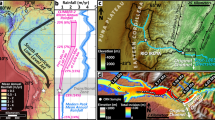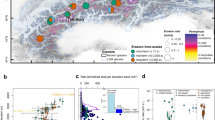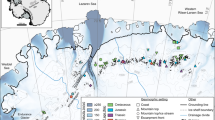Abstract
Past studies of tectonically active mountain ranges have suggested strong coupling and feedbacks between climate, tectonics and topography1,2,3,4,5. For example, rock uplift generates topographic relief, thereby enhancing precipitation, which focuses erosion and in turn influences rates and spatial patterns of further rock uplift. Although theoretical links between climate, erosion and uplift have received much attention2,6,7,8,9,10, few studies have shown convincing correlations between observable indices of these processes on mountain-range scales11,12. Here we show that strongly varying long-term (>106–107 yr) erosion rates inferred from apatite (U–Th)/He cooling ages across the Cascades mountains of Washington state closely track modern mean annual precipitation rates. Erosion and precipitation rates vary over an order of magnitude across the range with maxima of 0.33 mm yr-1 and 3.5 m yr-1, respectively, with both maxima located 50 km west (windward) of the topographic crest of the range. These data demonstrate a strong coupling between precipitation and long-term erosion rates on the mountain-range scale. If the range is currently in topographic steady state, rock uplift on the west flank is three to ten times faster than elsewhere in the range, possibly in response to climatically focused erosion.
This is a preview of subscription content, access via your institution
Access options
Subscribe to this journal
Receive 51 print issues and online access
$199.00 per year
only $3.90 per issue
Buy this article
- Purchase on Springer Link
- Instant access to full article PDF
Prices may be subject to local taxes which are calculated during checkout



Similar content being viewed by others
References
Beaumont, C., Kooi, H. & Willett, S. in Geomorphology and Global Tectonics (ed. Summerfield, M. A.) 29–55 (John Wiley & Sons, Chichester, UK, 2000)
Willett, S. D. Orogeny and orography: The effects of erosion on the structure of mountain belts. J. Geophys. Res. 104, 28957–28981 (1999)
Zeitler, P. K. et al. Erosion, Himalayan geodynamics, and the geomorphology of metamorphism. GSA Today 11, 4–9 (2001)
Koons, P. O. The topographic evolution of collisional mountain belts: A numerical look at the southern Alps. New Zealand. Am. J. Sci. 289, 1041–1069 (1989)
Montgomery, D. R. & Brandon, M. T. Topographic controls on erosion rates in tectonically active mountain ranges. Earth Planet. Sci. Lett. 201, 481–489 (2002)
Beaumont, C., Fulsack, P. & Hamilton, J. in Thrust Tectonics (ed. McClay, K. R.) 1–18 (Chapman and Hall, New York, 1991)
Willett, S. D., Beaumont, C. & Fullsack, P. Mechanical model for the tectonics of doubly vergent compressional orogens. Geology 21, 371–374 (1993)
Willett, S. D., Slingerland, R. & Hovius, N. Uplift, shortening, and steady state topography in active mountain belts. Am. J. Sci. 301, 455–485 (2001)
Tucker, G. E. & Slingerland, R. L. Erosional dynamics, flexural isostasy, and long-lived escarpments: A numerical modeling study. J. Geophys. Res. 99, 12229–12243 (1994)
Whipple, K. X., Kirby, E. & Brocklehurst, S. H. Geomorphic limits to climate-induced increases in topographic relief. Nature 401, 39–43 (1999)
Brozovic, N., Burbank, D. W. & Meigs, A. J. Climatic limits on landscape development in the Northwestern Himalaya. Science 276, 571–574 (1997)
Montgomery, D. R., Balco, G. & Willett, S. Climate, tectonics and the morphology of the Andes. Geology 29, 579–582 (2001)
Smiley, C. J. The Ellensburg flora of Washington. Univ. Cal. Publ. Geol. Sci. 35, 159–276 (1963)
Miller, M. M. et al. GPS-determination of along-strike variation in Cascadia margin kinematics: Implications for relative plate motion, subduction zone coupling, and permanent deformation. Tectonics 20, 161–176 (2001)
Dragovich, J. D., et al. Geologic Map of Washington—Northwest Quadrant, Washington 3 sheets, 1:250,000, 71 pages (Geologic Map GM-50, Washington Division of Geology and Earth Resources, Washington State Department of Natural Resources), (2002)
Tabor, R. W. et al. Geologic Map of the Skykomish River 30- by 60-minute Quadrangle, Washington 1 sheet, 1:100,000, 42 pages (US Geol. Surv. Misc. Invest. Ser. Map I-1963, 1993)
Tabor, R. W., Frizzell, V. A. Jr, Booth, D. B. & Waitt, R. B. Geologic Map of the Snoqualmie Pass 30 x 60 minute Quadrangle, Washington 1 sheet, 1:100,000, 57 pages (US Geol. Surv. Misc. Invest. Ser. I-2538, 2000)
Tabor, R. W. et al. Geologic Map of the Chelan 30-minute by 60-minute Quadrangle, Washington 1 sheet, scale 1:100,000, 29 pages (US Geol. Surv. Misc. Invest. Ser. Map I-1661, 1987)
Tabor, R. W. et al. Geologic Map of the Wenatchee 1:100,000 Quadrangle, Central Washington 1 sheet, 1:100,000, 26 pages (US Geol. Surv. Misc. Invest. Ser. Map I-1311, 1982)
Farley, K. A. Helium diffusion from apatite: General behaviour as illustrated by Durango fluorapatite. J. Geophys. Res. 105, 2903–2914 (2000)
Reiners, P. W. et al. Late Miocene exhumation and uplift of the Washington Cascades. Geology 30, 767–770 (2002)
Brandon, M. T., Roden-Tice, M. K. & Garver, J. I. Late Cenozoic exhumation of the Cascadia accretionary wedge in the Olympic Mountains, northwest Washington State. Geol. Soc. Am. Bull. 110, 985–1009 (1998)
Blackwell, D. D., Steele, J. L., Kelley, S. & Korosec, M. A. Heat flow in the state of Washington and thermal conditions in the Cascade range. J. Geophys. Res. 95, 19495–19516 (1990)
Daly, C., Neilson, R. P. & Phillips, D. L. A statistical-topographic model for mapping climatological precipitation over mountainous terrain. J. Appl. Meteorol. 33, 140–158 (1994)
Acknowledgements
We acknowledge comments by P. Molnar. We also thank S. Willett and M. Brandon for discussions, and S. Nicolescu for analytical assistance. This work was supported by the US National Science Foundation.
Author information
Authors and Affiliations
Corresponding author
Ethics declarations
Competing interests
The authors declare that they have no competing financial interests.
Supplementary information
Rights and permissions
About this article
Cite this article
Reiners, P., Ehlers, T., Mitchell, S. et al. Coupled spatial variations in precipitation and long-term erosion rates across the Washington Cascades. Nature 426, 645–647 (2003). https://doi.org/10.1038/nature02111
Received:
Accepted:
Issue Date:
DOI: https://doi.org/10.1038/nature02111
This article is cited by
-
Climatic control on the location of continental volcanic arcs
Scientific Reports (2022)
-
Apatite and zircon fission-track thermochronology constraining the interplay between tectonics, topography and exhumation, Arunachal Himalaya
Journal of Earth System Science (2021)
-
Impact of long term uplift on stream networks in tectonically active Northern Hill Range, Kachchh palaeo-rift basin, western India
Journal of Mountain Science (2021)
-
Topographic controls on the annual runoff coefficient and implications for landscape evolution across semiarid Qilian Mountains, NE Tibetan Plateau
Journal of Mountain Science (2020)
-
Mid–late Holocene fluvial aggradational landforms and morphometric investigations in the southern front of the Shillong plateau, NE India
Journal of Earth System Science (2019)
Comments
By submitting a comment you agree to abide by our Terms and Community Guidelines. If you find something abusive or that does not comply with our terms or guidelines please flag it as inappropriate.



